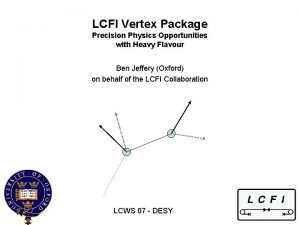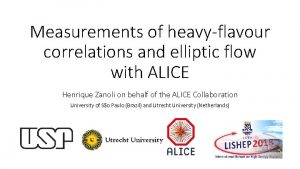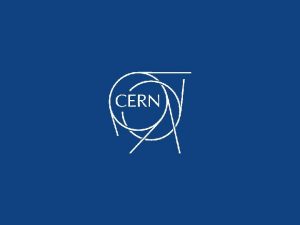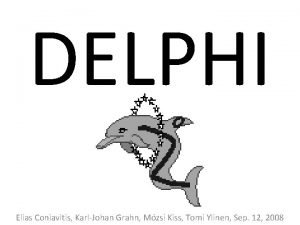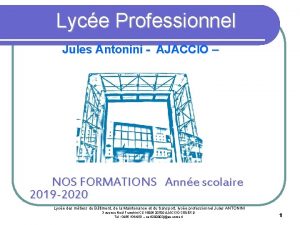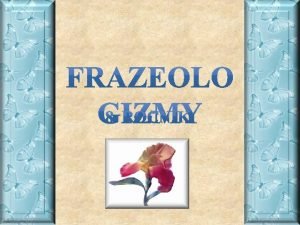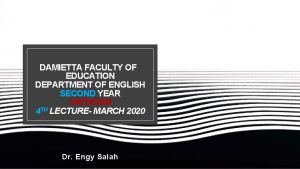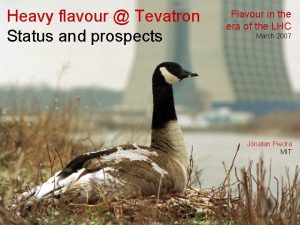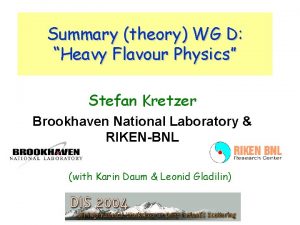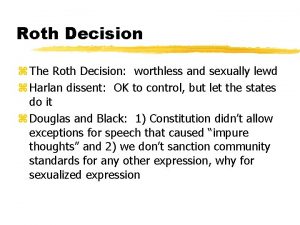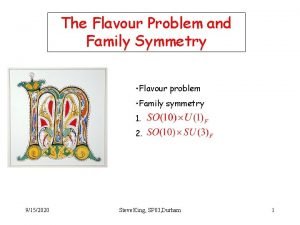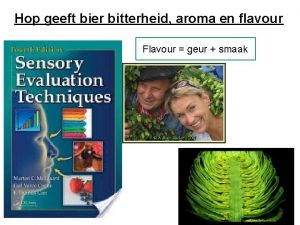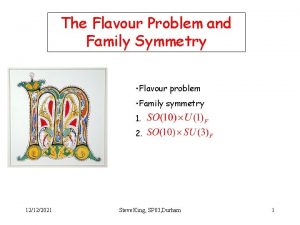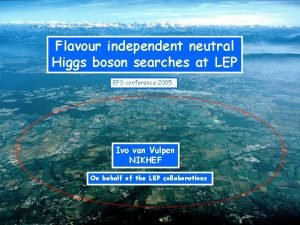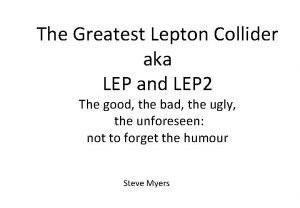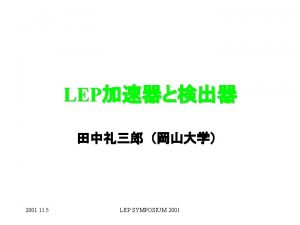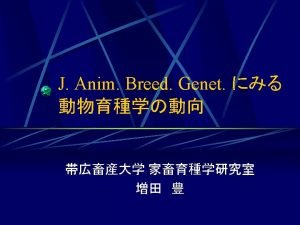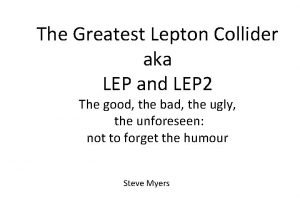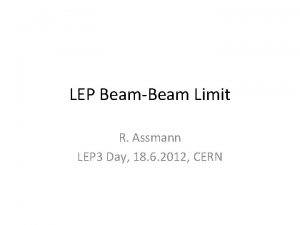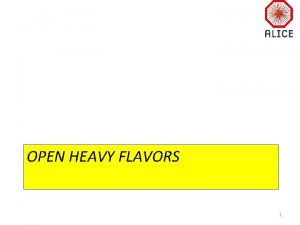ggProduction of Heavy Flavour at LEP Stefan Roth


















- Slides: 18

gg-Production of Heavy Flavour at LEP Stefan Roth RWTH Aachen L 3 Collaboration

Hadron Production at LEP Two photon collisions are the dominant source of hadrons at LEP 2

Selection of two photon events Two photon selection uses the low visible mass Wvis of the hadronic system Here: Use antitagged events (beam electrons escape) Delphi

Hadronic Final State in gg collisions Hadronic final states from produced four processes Direct Single Resolved Double Resolved Heavy flavour production is dominated by the first two processes VDM

Heavy flavours in gg collisions Test of perturbative QCD: Quark masses set high energy scale Direct Process depends on mc (mb) and as At LEP 2 energies: Resolved process of the same order as direct Resolved process depends on gluon content of the photon

D* Identification of Charm tag from decay: D*± ® D 0 p±s Peak in mass difference: Dm = m(D*) - m(D 0) = 145 Me. V Þ 6 Me. V kinetic energy for slow pion p ±s

Charm production cross section Evidence for gluon content of photon ! QCD calculation: M. Drees et al, Phys. Lett. B 306 (1993) 371

Direct and Resolved Contribution Use transverse momentum of D* x. TD* = 2 p. TD*/ Wvis

Charm production: Differential cross sections Pseudorapidity Agreement between data and NLO calculations Transverse Momentum

Charm production vs Wvis Data are in excess of Pythia MC for visible masses Wvis > 15 Ge. V Extraction of s(gg ® cc. X) Correction of detector acceptance Unfolding of detector resolution Unfolding of photon luminosity spectrum

Cross section of gg ® cc. X Wgg dependence of direct and resolved part are seen in data Agreement with NLO calculations only for small charm quark masses Steeper rise with visible mass as compared to s(gg ® hadrons)

Charm structure function Measurement of Fg 2, c usingle-tag events with inclusive D* 33 mrad < qe < 120 mrad PT(D*) > 1 Ge. V Þ <Q 2> = 20 Ge. V 2 Result for Fg 2, c x>0. 1 pointlike part calculable in QCD x<0. 1 hadron-like component

Search for Beauty in Two Photon Events Select leptonic decays of c or b quark Calculate Pt of lepton with respect to the nearest jet Fit resulting spectrum with uds, c and b content as free parameters Electrons Muons

Charm and beauty cross section Charm cross section reproduces D* result Beauty cross section in excess of QCD by 4 standard deviations

Source of beauty excess ? Plot transverse momentum of muon Direct and Resolved part is needed to describe shape of data distribution None of both can explain excess alone

Inclusive J/Y Production + - Identification of J/Y ® m m DELPHI selects 36 events with nearly full LEP 2 luminosity Distinguish diffractive/resolved part Measure cross section of resolved part ( g g ® J/Y ) Interpretation by M. Klasen et al. hep-ph/0112259 Colour Octet Model favoured J/Y is produced in hard process as CO Converts into physical colour singlett quarkonia by nonperturbative emission of soft gluons.

Search for hb Exclusive production via gg ® hb hb still undiscovered Estimates for Dm = m(¡) -m(hb) from lattice are O(100 Me. V) ALEPH: 1 candidate L 3: 3 candidates Mass from ALEPH event: 9. 30 ± 0. 02 Ge. V/c 2

Summary Charm: Differential distributions agree with QCD calculations Total inclusive charm cross section agrees with NLO calculations, but low charm quark masses preferred Gluon content of photon is important Charm structure function of photon measured Beauty: Cross section three times higher than NLO calculations Search for exclusive hb still ongoing.
 Heavy flavour
Heavy flavour Heavy flavour
Heavy flavour Michael cormac roth
Michael cormac roth Stefan roth rwth
Stefan roth rwth Ratey algebra 2
Ratey algebra 2 Condor job flavour
Condor job flavour Flavour enhancer 627 and 631 side effects
Flavour enhancer 627 and 631 side effects Clarence valley lep
Clarence valley lep Lep workshop
Lep workshop Lep l
Lep l Lep
Lep Tomi lep
Tomi lep Sitharthan
Sitharthan Lep jules antonini
Lep jules antonini South east midlands lep
South east midlands lep Sadnut niekomu na lep vyznam
Sadnut niekomu na lep vyznam Lep sidney
Lep sidney Roth robertson
Roth robertson John reece roth
John reece roth
